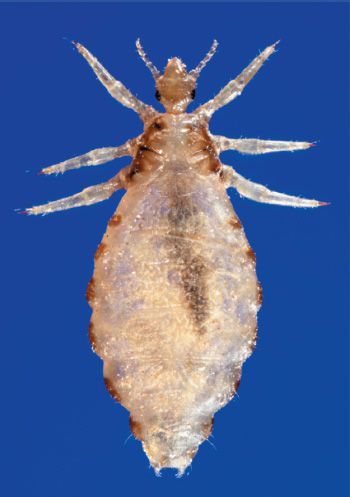69
Ectoparasites That Cause Human Disease
CHAPTER CONTENTS
INTRODUCTION
Ectoparasites are organisms that are found either on the skin or only in the superficial layers of the skin. Ecto is a prefix meaning “outer.” Virtually all ectoparasites are arthropods; that is, they are invertebrates with a chitinous exoskeleton.
The ectoparasites that cause human disease fall into two main categories: insects (six-legged arthropods) and arachnids (eight-legged arthropods). The ectoparasites discussed in this chapter include insects such as lice, flies, and bedbugs and arachnids such as mites, ticks, and spiders.
Many arthropods are vectors that transmit the organisms that cause important infectious diseases. A well-known example is the Ixodes tick that transmits Borrelia burgdorferi, the cause of Lyme disease. Table XII–3 describes the medically important vectors. However, in this chapter, the arthropods are discussed not as vectors, but as the cause of the disease itself. Table 69–1 summarizes the common features of diseases caused by the medically important ectoparasites that are described in this chapter. Ectoparasites of minor medical importance are briefly described at the end of the chapter.
TABLE 69–1 Important Ectoparasites That Cause Human Disease

INSECTS
1. Lice
Disease
Pediculosis is caused by two species of lice: Pediculus humanus and Phthirus pubis. P. humanus has two subspecies: Pediculus humanus capitus (head louse), which primarily affects the scalp, and Pediculus humanus corporis (body louse), which primarily affects the trunk. P. pubis (pubic louse) primarily affects the genital area, but the axilla and eyebrows can be involved as well.
Note that the body louse is the vector for several human pathogens, notably Rickettsia prowazekii, the cause of epidemic typhus, whereas the head louse and the pubic louse are not vectors of human disease.
Important Properties
Lice are easily visible, being roughly 2 to 4 mm long. They have six legs armed with claws by which they attach to the hair and skin (Figure 69–1). Pediculus has an elongated body, whereas Phthirus has a short body and resembles a crab, and hence its nickname, the crab louse. People infected with Phthirus are said to have “crabs.”
FIGURE 69–1 Pediculus corporis—body louse. Note the elongated abdomen of Pediculus corporis. In contrast, the pubic louse has a short “crab-like” abdomen. (Figure courtesy of Dr. F. Collins, Public Health Image Library, Centers for Disease Control and Prevention.)
Nits are the eggs of the louse and are typically found attached to the hair shaft (Figure 69–2). They are white and can be seen with the naked eye. Nits of the body louse are often attached to the fibers of clothing.
FIGURE 69–2 Pediculus capitis—egg case (nit). Arrow points to an egg case (also known as a nit) attached to hair shaft. Note embryo within egg. (Figure courtesy of Dr. D. Juranek, Public Health Image Library, Centers for Disease Control and Prevention.)
Transmission
Head lice are transmitted primarily by fomites such as hats, combs, and towels. These are especially common in school children. Body lice live primarily on clothing and are transmitted either by clothing or by personal contact. Body lice leave the clothing when they require a blood meal. Pubic lice are transmitted primarily by sexual contact.
Widespread infestations of body lice occur when personal hygiene is poor (e.g., during wartime or in crowded refugee camps).
Pathogenesis
Adult lice feed on blood and, in the process, inject saliva into the skin, which induces a hypersensitivity reaction and, as a consequence, pruritus.
Clinical Findings
Pruritus is the main symptom. Excoriations may result from scratching, and secondary bacterial infections may occur. In pediculosis capitis, the adult lice are often difficult to see, but the nits are easily visualized. In pediculosis corporis, the adult lice are primarily in the clothing rather than on the body. In pediculosis pubis, the adult lice and nits can be seen attached to the pubic hair.
Laboratory Diagnosis
The laboratory is not involved in diagnosis. Nits fluoresce under ultraviolet light of a Wood’s lamp, which can be used to screen the hair of large numbers of people.
Treatment
Permethrin (Nix, RID) is the treatment of choice, as it is both pediculicidal and ovicidal. However, resistance to permethrin is increasing. Ivermectin (Sklice) is also effective, and resistance has not been reported. Nits are removed using a fine-toothed (nit) comb. Patients with body lice often do not need to be treated, but the clothing should be either discarded or treated.
Prevention
Children should not share articles of clothing. Many schools have a policy that children cannot attend school until they are nit-free, but the need for this exclusionary approach is under review. The personal items of affected individuals, such as towels, combs, hair brushes, clothing, and bedding, should be treated. Sexual partners of those infested with pubic lice should be treated and tested for other sexually transmitted diseases.
2. Flies
Disease
Myiasis is caused by the larva of many species of flies, but the one best known is the botfly, Dermatobia hominis. Fly larvae are also known as maggots. Note that maggots are occasionally used to débride nonhealing wounds, but these maggots do not cause myiasis.
Important Properties
The flies that cause myiasis are found worldwide and infest many animals as well as humans. Human infestation occurs most often in tropical areas. Dermatobia is common in Central and South America.
Transmission
Stay updated, free articles. Join our Telegram channel

Full access? Get Clinical Tree




